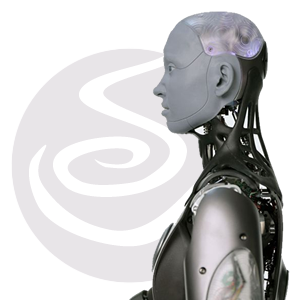Ambidextrous Ameca The Robot - Futurism and Storytelling in a Nutshell- Free Lesson
"It’s the year 2055 and what once was a toy rabbit awkwardly hopping on its own mechanical whim, is now jumping and running faster than a human. It can now, with fluid motion, jump over a large truck and continue its smooth stride. It’s not human enough to try out for the Olympics, however it has been recognized as the fastest techno-rabbit on the block and receives an award from the Guinness Book of A.I. achievements for furthest mecha-leaper. Chanting and cheers erupt from the audience as other animal mechanoids yield support for their futuristic friends.
With advances in AGI (Artificial General Intelligence) climaxing and with the potential future singularity, how can we leverage the power of singularity with imperfect humanism. It may be that, we need to create a sense of forced fallibility within superintelligent systems by means of machine learning clauses, vital awareness, and ethical statutes.  For humans, there seemingly vital source of fuel and energy are derived from ingested food and liquids whereas robotic machines use direct current. Humans display different varying levels of energy and moods dependent upon what types foods and amounts they eat. With future super-intelligent machines, electrical power adjustments and machine learning algorithmic clauses could determine a mood for a robot by increasing or decreasing throughput and processing speed in relation to their specific power levels. The hibernation of a system depleted of electricity and energy constraints could be analogous to a human nap.
For humans, there seemingly vital source of fuel and energy are derived from ingested food and liquids whereas robotic machines use direct current. Humans display different varying levels of energy and moods dependent upon what types foods and amounts they eat. With future super-intelligent machines, electrical power adjustments and machine learning algorithmic clauses could determine a mood for a robot by increasing or decreasing throughput and processing speed in relation to their specific power levels. The hibernation of a system depleted of electricity and energy constraints could be analogous to a human nap.
Quantum battery discoveries show us the possibility of near perpetual energy, however perhaps this is the ultimate downside and scare towards integrating superintelligence fashioned by a bot. By utilizing neural networks containing vitals data, most importantly variable electricity levels, a superintelligent robot could be aware of its own varying power supply and increase or decrease its activities accordingly to its fixed energy capacity, and perhaps even its own throughput.
A.I. ethical commandments from oversight committees could help guide humanity once quantum computers, A.I., advanced robotics, and the potential singularity combine and give rise to fast forming entities of evolution .
The Figure 02 robot is an advanced humanoid robot developed by Figure AI, designed to perform a wide range of tasks in industrial and commercial settings. It features a highly articulated body with AI-driven perception and decision-making capabilities, allowing it to navigate and interact with its environment efficiently. The robot is intended to address labor shortages by performing physically demanding or repetitive jobs, making it a potential asset in warehouses, manufacturing, and other industries. Figure 02 is part of the broader push toward general-purpose humanoid robots, competing with models from companies like Tesla (Optimus) and Boston Dynamics.
The Optimus Robot, also known as Tesla Bot, is a humanoid robot developed by Tesla, Inc. It is designed to perform repetitive or dangerous tasks, helping to automate physical labor. Optimus is powered by Tesla’s AI and uses technology from the company’s self-driving cars, including computer vision, sensors, and actuators for smooth movement.
The SE01 is a full-sized humanoid robot developed by Shenzhen EngineAI Robotics, unveiled on October 24, 2024. Standing 170 cm tall and weighing 55 kg, SE01 features 32 joints capable of producing a maximum torque of 330Nm. Its advanced end-to-end neural network system enables it to perform human-like movements such as squatting, push-ups, walking in circles, grasping, running, and jumping, with a walking speed of up to 2 meters per second. The robot's body is constructed from aerospace-grade aluminum alloy, ensuring durability and a lifespan of over 10 years.
